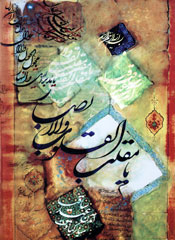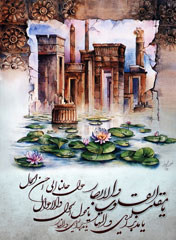Ink a better future
Calligraphy has always been pursued as a hobby. With the changing times, however, this art has become a sought after profession. From card designing to brand imaging purposes, the calligrapher is called upon to lend his artistic touch. Aastha Khurana reports
Calligraphy is an art of the beautiful, stylized, or elegant handwriting or lettering with pen or brush and ink. Being an ancient form of art, which used to be pursued as a hobby, today it has transformed into a unique career option.
There are different styles of calligraphy like Arab calligraphy, Chinese calligraphy, Japanese calligraphy, and various other calligraphy fonts.
It involves the correct formation of characters, the ordering of the various parts, and the harmony of proportions. «When a person learns to write, he becomes literate and when he understands the essence of letters he transforms into an artist. It is equally beautiful in black & white as it is in colors. A true artist will manipulate its strokes to create paintings,» says Achyut Palav, a world renowned calligrapher who also started the Achyut Palav School of Calligraphy based in Mumbai.
Scope
«Many believe that with the technological era, people would opt to do everything they used to do manually on the computer, however, what can be done with the hand, cannot be replaced by a machine. There are people in the market who recognize this and are willing to pay a price for manual labour,» says Harish Chander, managing director, Calligraphy India.
Other reputed calligraphers are also of the opinion that the calligraphy is not doomed. «I can suggest to potential calligraphers that they keep practicing calligraphy as a part-time job to make a living until they have mastered the art completely,» Palav tells you.
Calligraphers could also work with digital media and designing software as well. Being comfortable working with both physical and virtual canvases is important. A sense of innovation helps the calligraphers put their skill to novel use and reap the consequent benefits.
Eligibility
«For aspiring calligraphers, a range of long and short term courses are offered in India. The field is so vast that one can learn the basics in a short period of time, or delve into the depths over an extended time period and yet never learn it all. The multitude of fonts, styles, scripts, and strokes is the primary reason,» says Palav.
There are many short-term, regular, and other courses that are available at institutes depending on the time one has. «As far as calligraphy is concerned there are no age-related restrictions. No specific degree is required to learn this art. Although a background in fine arts is a valuable asset,» Chander tells you.
Skills required
«To become a calligrapher one need not be good at drawing, nor have a good handwriting. One just needs a broad mind and should yearn to see beyond the certain rigidity of letters that have been embedded in our minds,» says Palav. Calligraphy is a skill that is honed and perfected. In order to be a good calligrapher, one must have the driving desire to create beautiful images, motifs and symbols. An aesthetic sense and gauge of artistic balance is also necessary. While these skills can be cultivated over time, they are also partially innate. As long as one is a keen learner, and is willing to practice until perfection, sky is the limit. «One needs to be diligent and practice regularly. The first step is to make your hand steady, which only comes over a period of time,» Palav tells you.
Job prospects
The job prospects for this art are limitless. For those looking to teach calligraphy or conduct workshops, good interpersonal skills are necessary. Those with entrepreneurship tendencies can devise a product line that uses calligraphic elements. Wedding invitation cards are one of the biggest clients of calligraphy services. From the design page with shlokas on it to the wedding ceremony details inside and the names and addresses on the envelopes, calligraphers can do wonders with their skills. «One can work as a freelancer, start their own calligraphy business, or look for a career in calligraphy at print shops, publishing houses, and wedding planners. Besides wedding cards, the calligraphy portfolio can include samples of business cards, birthday cards, party invitation cards and even the name cards to place on the table or seats for guests at an event or party,» says Harish.
Logo designs also play a big role in brand image and corporate identity. And calligraphers play a significant role in coming up with logo designs and brand imaging ideas.
Hoarding designs, making signboards, graphic designing such as desktop wallpapers, and packaging designs use calligraphy as well.
Remuneration
Calligraphy as a profession can fill in hours and bring in the money. Most people like the graceful calligraphy styled wording on invitations that lends it a more personal touch. «Calligraphy gives a sense of purpose and a means of making money».«Be it a part time job or full time career, this art of words has the moolah, depending on the level you would like to take it to. The initial returns may not be as satisfying, but once you’re an expert, you can demand a higher price,» says Harish.
Where to Study
- Indira Gandhi National Centre for Arts (IGNCA), New Delhi
- Calligraphy India, New Delhi
- Achyut Pallav School of Calligraphy, Mumbai.
Source: The Pioneer


